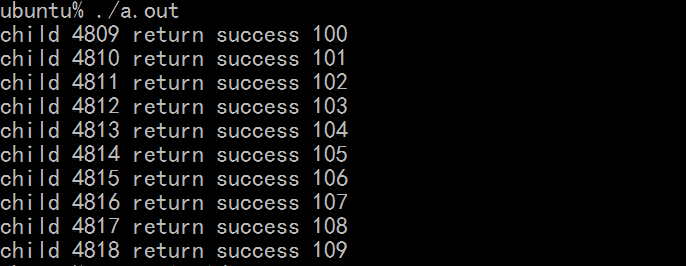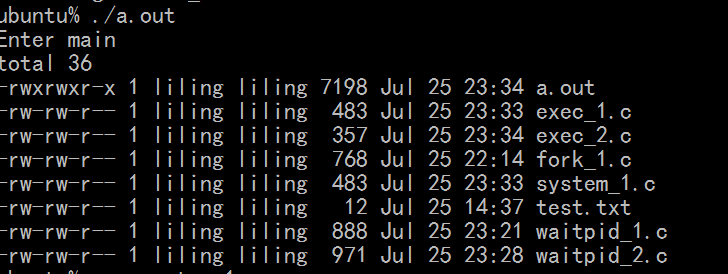1. fork
1.1 通过 fork 创建的父子进程对于fork之前打开的fd,共享文件偏移量。这是因为,父进程fork一个子进程后,会有自己的进程表项,因此二者各有一套相同的文件描述符表,他们共享了文件表项,因而也就共享了偏移量。此外,close 的关闭采用的是引用计数,当执行close时,是把该fd 窒息那个的的内核中的文件表现的引用计数减1,仅当引用计数为0 时,才是真正的销毁该结构。
#include <stdio.h>
#include <stdlib.h>
#include <string.h>
#include <fcntl.h>
#define ERR_EXIT(m)
do {
perror(m);
exit(EXIT_FAILURE);
}while(0)
/*
* 父子继承共享文件偏移量
*/
int main(int argc, const char *argv[])
{
int fd = open("test.txt", O_RDONLY);
if(fd == -1){
ERR_EXIT("open");
}
pid_t pid;
if((pid = fork()) < 0){
ERR_EXIT("fork");
}
else if(pid == 0){
char buf[10] = {0};
read(fd, buf, 3);
printf("in Child buf = %s
", buf);
close(fd); //此处引用计数 减 1
}
else{
sleep(3);
char buf[10] = {0};
read(fd, buf, 3);
printf("in parent buf = %s
", buf);
close(fd);
}
return 0;
}
1.2 目前我们碰到的共享文件偏移量的情况有 2 种:
a)通过dup 等手段复制fd,此时两个fd 共享文件偏移量(文件表项);
b)fork 父子进程,二者共享文件偏移量。
1.3 shell的工作原理:当我们在键盘上敲入”ls”的时候
a)shell(bash、zsh)先fork一个子进程
b)将子进程的代码使用exec替换为“ls”
c)shell负责该子进程的回收
1.4 对于经典的fork+exec的组合模式,fork出子进程再进行替换,那么复制完整的子进程的地址空间是无意义的。所以提出两种解决方案:
a)vfork:vfork的目的就是为了exec;
b)对于fork采用写时复制技术。
1.5 fork的写时复制技术:
a)fork子进程时,仅仅复制页表项,而不是具体的进程空间。同时将地址空间设为只读。
b)每当任何一方试图修改地址空间时,就自己复制一份。
1.6 写时复制(COW)使得父子进程,在物理上共享地址空间的,但是在逻辑上地址空间是相互独立的。
2.关于父子进程的处理
2.1 处理僵尸进程的手段:
a)处理SIGCHLD信号;
b)采用wait、waitpid。
2.2 如果没有任何子进程,那么执行wait时,会立刻返回-1,同时errno为ECHLD。否则阻塞,使用WNOHANG可以避免阻塞。
2.3 waitpid不是按照顺序回收子进程。
2.3.1 不按照顺序回收的例子。
#include <stdio.h>
#include <stdlib.h>
#include <string.h>
#include <errno.h>
#include <sys/types.h>
#include <sys/wait.h>
#define ERR_EXIT(m)
do {
perror(m);
exit(EXIT_FAILURE);
}while(0)
#define N 10
int main(int argc, const char *argv[])
{
int i;
pid_t pid;
for(i = 0; i < N; i++){
if((pid = fork()) < 0){
ERR_EXIT("fork");
}
else if(pid == 0){
exit(100 + i); //子进程返回退出码
}
}
int status;
while((pid = waitpid(-1, &status, 0)) > 0){//回收所有的子进程
if(WIFEXITED(status)){// 判断子进程是否正常退出
printf("child %d return success %d
", pid, WEXITSTATUS(status));
}
else
printf("chidl %d return errno
", pid);
}
if(errno != ECHILD){
ERR_EXIT("waitpid");
}
return 0;
}

2.3.2 若要顺序回收,可以用waitpid 一次等待每个特定的pid,若没有等到,会一直阻塞。
#include <stdio.h>
#include <stdlib.h>
#include <string.h>
#include <errno.h>
#include <sys/types.h>
#include <sys/wait.h>
#define ERR_EXIT(m)
do {
perror(m);
exit(EXIT_FAILURE);
}while(0)
#define N 10
/*
* 顺序回收
*
*/
int main(int argc, const char *argv[])
{
int i;
pid_t pid[N];
for(i = 0; i < N; i++){
if((pid[i] = fork()) < 0){
ERR_EXIT("fork");
}
else if(pid[i] == 0){
exit(100 + i); //子进程返回退出码
}
}
int status;
i = 0;
pid_t ret;
while((ret = waitpid(pid[i], &status, 0)) > 0){//回收所有的子进程
if(WIFEXITED(status)){// 判断子进程是否正常退出
printf("child %d return success %d
", ret, WEXITSTATUS(status));
}
else
printf("chidl %d return errno
", pid[i]);
i++;
}
if(errno != ECHILD){
ERR_EXIT("waitpid");
}
return 0;
}

2.4 system与exec区别:
a)exec替换的是当前进程
b)system则是创建子进程,然后调用exec替换
2.4.1 exec的例子。
#include <stdio.h>
#include <stdlib.h>
#include <string.h>
#include <unistd.h>
#include <errno.h>
#define ERR_EXIT(m)
do {
perror(m);
exit(EXIT_FAILURE);
}while(0)
int main(int argc, const char *argv[])
{
printf("Enter main
");
execlp("ls", "ls", "-l", NULL);//替换当前子进程
printf(" Leave main
");
}

2.4.2 system的例子。
#include <stdio.h>
#include <stdlib.h>
#include <string.h>
#include <unistd.h>
#include <errno.h>
#define ERR_EXIT(m)
do {
perror(m);
exit(EXIT_FAILURE);
}while(0)
int main(int argc, const char *argv[])
{
printf("Enter main
");
system("ls -l");
printf(" Leave main
");
}

2.5 system的实现:
a)创建子进程
b)子进程采用exec进行进程替换
c)父进程回收子进程,注意EINTR
2.6 守护进程与普通进程的区别:(这个有时间要再看一遍)
a)守护进程不属于shell所在的会话组
b)当shell退出的时候,守护进程不受影响